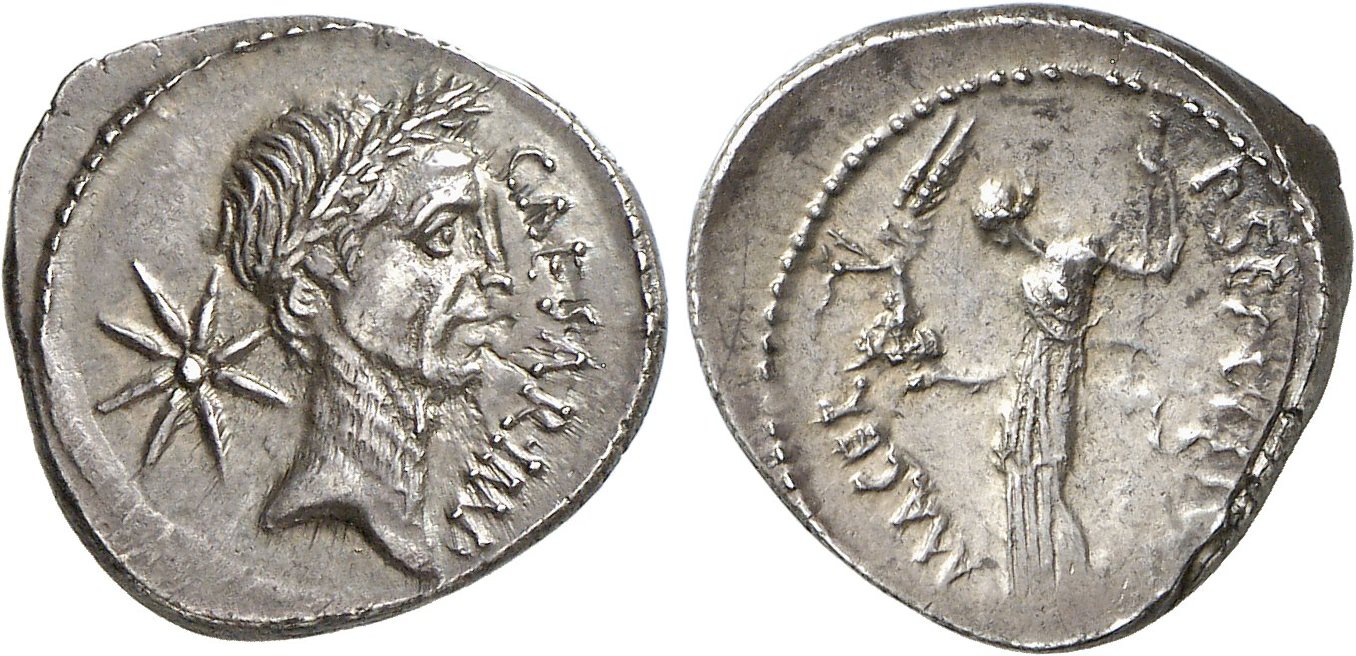Additional References: Crawford 480/5b
Notes: Wreathed head of Caesar facing right, eight-rayed star behind / Venus standing facing left, holding victory and scepter with star at base.
Obverse: Gaius Julius Caesar was born on 13 July, 100BC and lived until his assassination in 44BC. He was born into the Roman Noble patrician family, Julius. From an early age he became involved in Roman politics. The appointment by his uncle-by-marriage, Gaius Marius, to the position of Flamen Dialis pushed him into the Roman Senate as a teenager. From this time on, he stayed at or close to the center of Roman politics until his murder in Rome by conservative senators who wished to undermine many of the changes Caesar sought to implement to counteract the immense pressure created by the rapid expansion of the Republic over the preceding 100 years.
His greatest military accomplishment was the absorption of Gaul (modern day France) into the Roman Republic. This conquest brought him immense wealth and power which became the bedrock of his support by the Roman people. Unfortunately, from an early age onward, his view of how to solve the growing pains of the Republic differed vastly from those of more conservative elements of the Roman ruling class, the senate. These disagreements flared into legal challenges and eventually outright war when Caesar made his famous crossing of the Rubico river in 49BC.
His defiant stance against the senate conservatives (known as the boni or "good ones") was the root of this war. Although Caesar was initially victorious and defeated the leader of the conservatives, Pompey the Great, he made too many political enemies in the process and 5 years after the famous crossing, his enemies murdered Caesar at a gathering of the senate.
His greatest military accomplishment was the absorption of Gaul (modern day France) into the Roman Republic. This conquest brought him immense wealth and power which became the bedrock of his support by the Roman people. Unfortunately, from an early age onward, his view of how to solve the growing pains of the Republic differed vastly from those of more conservative elements of the Roman ruling class, the senate. These disagreements flared into legal challenges and eventually outright war when Caesar made his famous crossing of the Rubico river in 49BC.
His defiant stance against the senate conservatives (known as the boni or "good ones") was the root of this war. Although Caesar was initially victorious and defeated the leader of the conservatives, Pompey the Great, he made too many political enemies in the process and 5 years after the famous crossing, his enemies murdered Caesar at a gathering of the senate.
Denomination: In the Roman currency system, the denarius was a small silver coin first minted about 211 BC during the Second Punic War. It became the most common coin produced for circulation but was slowly debased in weight and silver content until its replacement by the double denarius, called the antoninianus, early in the 3rd century AD. The word denarius is derived from the Latin dēnī "containing ten", as its value was 10 asses, although in the middle of the 2nd century BC it was recalibrated so that it was now worth sixteen asses or four sestertii. It is the origin of several modern words such as the currency name dinar; it is also the origin for the common noun for money in Italian denaro, in Portuguese dinheiro and in Spanish dinero.
From Wikipedia
From Wikipedia
Period: Imperatorial Rome. As the Roman Republic began to implode because of
corruption and infighting among powerful members of the Roman Senate, a new type of
Roman Republican coinage emerges, that of the military strongmen who dominated and
fought amongst each other before the final fall of the Republic. The drama surrounding
the fall of the Roman Republic is a story full of political intrigue, military action, betrayal,
murder and sex scandals. Different parts of this story have been told and retold by
ancient historians, modern day scholars, dozens of Hollywood movies and even an HBO
miniseries. All of the actors in this great drama, Crassus, Pompey, Julius Caesar, Brutus
and Cassius, Mark Antony and Cleopatra and the last man standing at the end of it all,
Octavian (later known as the first emperor of Rome, Emperor Augustus) all minted coins
during this time bearing their names and propaganda images supporting their factions
and political ideals.
Culture: Ancient Rome. A famous catch phrase "Rome was not built in a day"
definitely applies to the Roman civilization. Rome stated as a series of small villages among the
famous seven hills of Rome along the river Tiber. Eventually through conquest, diplomacy, wise
policies of indirect rule and assimilation, the Romans were able to not only unify the Italian
peninsula, but though a series of brutal wars against regional powers established a great Empire
that spanned Europe, Asia and Africa, making the Mediterrean Sea and "Roman Lake."
All Roman coinage can generally be divided into eight time periods as described below. An interesting thing about Roman coins minted during these eight time periods is that you can literally see the "Rise and Fall" of the Roman Empire on its coinage as the sharp imagery and pure silver and gold coins of the Roman Republic and Early Imperial Period gradually devolves into crude, illegible and heavily debased coins of the "Barracks Emperors" and "Barbarian" Period.
All Roman coinage can generally be divided into eight time periods as described below. An interesting thing about Roman coins minted during these eight time periods is that you can literally see the "Rise and Fall" of the Roman Empire on its coinage as the sharp imagery and pure silver and gold coins of the Roman Republic and Early Imperial Period gradually devolves into crude, illegible and heavily debased coins of the "Barracks Emperors" and "Barbarian" Period.
Item created by: George on 2016-08-13 17:46:32
If you see errors or missing data in this entry, please feel free to log in and edit it. Anyone with a Gmail account can log in instantly.
If you see errors or missing data in this entry, please feel free to log in and edit it. Anyone with a Gmail account can log in instantly.






